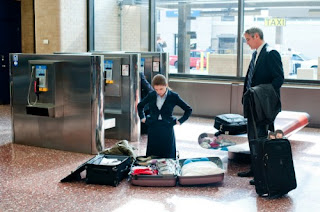***1/2 out of ****
Directed by: Rob Marshall
Starring: Daniel Day-Lewis, Penelope Cruz, Marion Cotillard, Nicole Kidman, Judi Dench and Kate Hudson
Running time: 118 minutes
Nine - based off a Broadway hit inspired by Fellini’s classic psychodrama, 8½ - is slick, stylish and sexy. It’s a musical that’s as classy as it is sassy, and it put a spell on me.
Guido Contini (Daniel Day-Lewis) is a beloved Italian director in the mid-1960s. He’s nicknamed “Maestro” by Italian audiences who are floored by his cinematic genius.
There’s a saying: “Behind every great man, there’s a great woman.” Behind Guido Contini, there are seven.
“Maestro” is having a tough time grasping his latest project, an ambitious work titled “Italia,” due to the relationships he has with the seven women around him.
These ladies include his seductive mistress, Carla (Penelope Cruz), his leading actress and muse, Claudia (Nicole Kidman), his trustworthy costume designer, Lili (Judi Dench), a flirtatious arts journalist, Stephanie (Kate Hudson), and a prostitute from his youth, Saraghina (Stacy “Fergie” Ferguson).
Rounding off the group of seven is his mother (a rarely used Sophia Loren) and his wife, Luisa (Marion Cotillard), a delicate beauty who’s shattered by her husband’s relentless passion for making movies and romancing other women.
As Contini tells reporters early on in Nine, to talk about a movie is to spoil its mystery. As much as I agree, I’ll give you a few – say, nine – reasons that the film is worth seeing.
1)) (1) Daniel Day-Lewis. Sure, he doesn’t look Italian. But it’s nice to see the two-time Oscar-winner cut loose in a role that’s both challenging (two solos for his repertoire) and fun (clothed in a skinny suit and sunglasses, Day-Lewis gets to dance, romance and smoke up a storm).
2) (2) Rob Marshall. It’s been almost seven years since his film debut, Chicago, danced away with the Best Picture Oscar. It’s nice to see he’s found his footing with another project. The same vigor, sensuality and charm found in Chicago are all on display here.
(- (3) Penelope Cruz. She’s smoking, and I’m not talking about cigarettes.
4) (4) John Myhre. The production designer, also responsible for Chicago and Dreamgirls, has only one stage to work with for the musical numbers (thanks for the budget cuts, Weinsteins). Still, he makes us forget that by designing colourful, dynamic numbers and making them work efficiently with the space.
5) (5) Marion Cotillard. She’s captivating and an exceptional singer. Even if you already knew that from La Vie en Rose, she, nevertheless, demands the screen in two of the film’s best numbers – the heart-wrenching “My Husband Makes Movies” and the flat-out dazzling “Take it All.”
6) (6) A sly, witty script from Michael Tolkin and the late Anthony Minghella.
7) (7) The two biggest show-stoppers come from a Dame (Judi Dench) and a Black Eyed Pea (Fergie). Dench struts her stuff with ease and elation in the song "Folies Bergeres," while Fergie has serious simmer in her number, “Be Italian.”
8) (8) Dion Beebe’s cinematography. Another reliable crew-mate of Marshall’s, the camera indulges in as much hot-boiled fancy as Guido himself.
9) (9) The last scene. It’s elegant and exciting and crescendoes to the perfect closing line.
Nine is impressive and full of moment-to-moment pleasures, even if some of songs don’t measure up to Chicago’s, and some supporting characters (Kate Hudson’s journalist and Sophia Loren as “Mamma,” in particular) receive little development.
Regardless, it is supreme entertainment that pops with fiery excitement. To borrow a term from Marshall’s earlier picture, it simply razzle dazzles.























.jpg)



